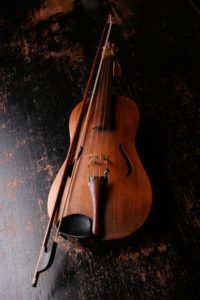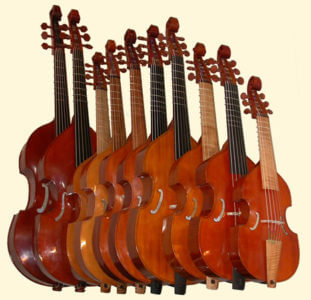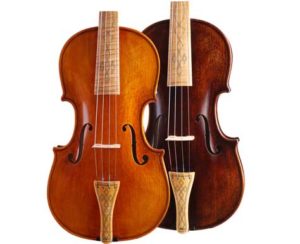History of the Violin
How did the violin you have in your hands today evolve through the ages?
The violin is the most popular member of the violin family, that now exists out of the violin, viola and cello
The violin was first made in early 16th century Italy
Predecessors of the violin
 The violin was likely developed from 15th and 16th century bowed instruments, like the vielle, rebec and lira de braccio.
The violin was likely developed from 15th and 16th century bowed instruments, like the vielle, rebec and lira de braccio.
The rebec is a small pear shaped Medieval bowed instrument, that was replaced by the vielle and later the violin in the centuries after. The vielle looks a bit like the violin, but the sound box is shaped differently.
The shape of the violin origins from the lira da braccio, a bowed instrument that was played in the renaissance and mainly in Italy.
Other early types of violins are the viola d’amore, viola da braccio, viola da gamba and the violincello da spalla.
During the following centuries there were two families of bowed instruments
One type was more violin shaped and was called the lira da braccio family, which means a viol for the arm. The violin origins mainly from this family, but of course is influenced by all bowed instruments throughout the centuries.
 The other type was the viola da gamba, with sloping shoulders and held between the knees. The term means viol for the leg.
The other type was the viola da gamba, with sloping shoulders and held between the knees. The term means viol for the leg.
During the Renaissance the gambas were important and elegant instruments. There were gamba consorts with different sizes of gamba’s.
The gamba family eventually lost ground to the louder (and originally viewed as less aristocratic) lira da braccio family of the modern violin.
These days double basses are still produced in violin shape and gamba shape. Because of the larger soundbox, this shape is suitable for a double bass.
Emergence of the violin
The violin emerged around 1550 in the areas Brescia and Cremona in Italy. It’s unknown who built the very first violin. The first important violin maker family in Cremona was Amati. Later the famous violin maker Stradivarius lived and worked in the same area.
These days most violins are built after the design by Stradivarius. Some violins today are built after the design by Guarneri.
The violins built by Stradivarius, Guarneri and Amati are still being played on by soloists and sell for millions. We will never know the secrets of these famous makers and artists.
Today Cremona is still the world wide center of violin makers. A lot of makers work there, there are schools for violin making and there is a violin museum. Every year the Mondomusica is organized: a market place for high quality bowed instruments.
From baroque violin to the modern violin
 Throught the centuries the violin is adjusted to the style of music and performance. In the 19th century the concert halls were bigger and the violin had to sound louder to fill the room.
Throught the centuries the violin is adjusted to the style of music and performance. In the 19th century the concert halls were bigger and the violin had to sound louder to fill the room.
The violin that was played from the 16th century to the 18th century is called the baroque violin. The violin that is played after that is called a modern violin. These definitions aren’t very strict as there were instruments that are in between these two types. Development went organically and not in one day.
Differences between the modern violin and the baroque violin:
- The neck is longer and is placed in a different angle.
- The fingerboard is longer to allow playing in high positions and reach higher notes in the virtuosic music of the 19th century
- The fingerboard is made out of ebony instead of maple to be able to cope with the higher string tension and the new angle of the neck
- The bridge is higher and thinner to create a larger tone and compensate for the new angle of the neck
FREE Violin Scale Book
Sensational Scales is a 85 page violin scale book that goes from simple beginner scales with finger charts all the way to all three octave scales and arpeggios

Hi! I'm Zlata
Classical violinist helping you overcome technical struggles and play with feeling by improving your bow technique.
Violin developments in the 20th century
Lots of violin players think they play on the same violin that was played in the 19th century. However there are certainly some developments in the last decades.
From gut strings to steel strings and synthetic core strings
In the 19th century and before violins were equiped with gut strings. Metal windings were too expensive until about 1900. By then electricity became the big thing and copper wire was mass produced for cables. This copper wire was then used for winding the lower (gut) strings to give them more punch.
At the same time the quality of steel improved to the point where thin wires could be made strong enough to be used as violin E-strings.
It was as late as the seventies when gut core strings were replaced by synthetic core strings with metal, silver, alumium or gold winding.
The new type of strings make a larger tone and have a better tuning stability. They are less sensitive to changes in temperature and humidity. Also they last longer.
Despite of these advantages there are still violin players who are charmed by the warm and rich sound of gut strings. Most gut strings played today are wound gut strings, with exception to historical performance practices.
Chinrest and shoulder rest
Now we have so many comfortable chinrests and shoulder rests to chose from, but until the fifties and sixties of the 20th century almost all violinists played without shoulder rest. Also chinrests have become larger to provide more support and height.
A combination of a good chinrest and shoulder rest can solve a lot of problems, but playing without shoulder rest gives you a lot of freedom of movement and practice in balance.
Carbon fiber bows
In the last decades there was some very interesting development in the violin bow for the first time in almost two centuries! Read more about that in my article ‘History of the Violin Bow’.
What was the most surprising fact in this article to you? Leave a comment below!


Thank you Zlata !! your posts are always informational,entertaining and inspiring
Thanks for being part of my digital audience, Barry!
Thanks! Nero could not have fiddled as Rome burned! (There weren’t any fiddles!!). So many old wives tales, indeed!
Your information is always helpful!
Exactly, Anita!
Ms. Brouwer, what do you think the idea was in the maker’s heart when he created the violin?
-Zoe Hinton
I think to replicate the human voice :).